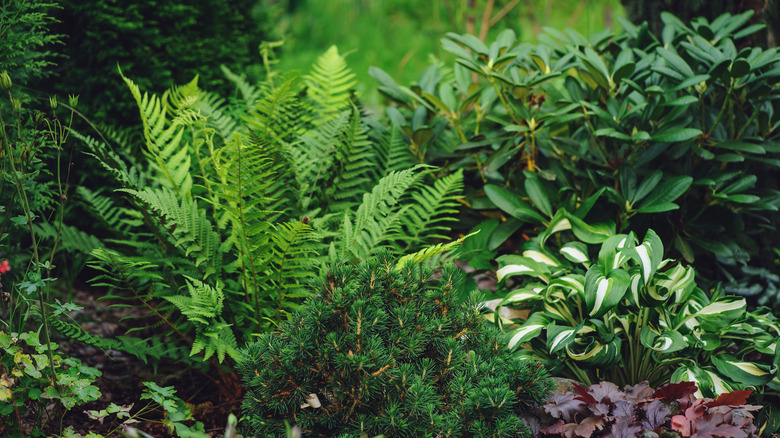The Stunning Garden Trifecta That Looks Beautiful In Shady Areas
Your garden doesn't need to be all sunshine to shine — hostas (Hostaceae), ferns (Polypodiopsida) and periwinkles (Vinca minor) prove that shade-loving plants can steal the show, too. If you have a shady spot in your garden, you'll want to make sure to cultivate the right plants. To start, identify the type of shade in your garden. Full shade areas get less than two hours of sunlight per day and are typically found on the darker sides of houses, under large trees, or near dense hedges. Partial shade, on the other hand, receives between two and six hours of sunlight and is commonly found under trees or next to walls or sheds. Understanding these differences will help you choose the right plants for each spot.
For instance, periwinkles love partial shade, so choose spots next to your taller landscape features such as walls or under less-dense trees. Consider planting companion plants such as Ostrich Fern (Matteuccia struthiopteris), which is native to the United States. Its familiar fronds grow up to 4 feet tall, adding visual interest to your garden when contrasted with low-lying periwinkle ground cover. Hostas also pair well with periwinkles, with the green-leaved type preferring partial shade, while hostas with blue leaves tend to need full shade. Shade gardens often play with textures and shapes as opposed to color, and a hosta's broad leaves contrast well with the more delicate fern fronds. Whatever you choose, use the sunlight — or lack thereof — to your advantage to let your shade-loving periwinkles shine!
How to plant and care for your shade garden
It's important to know how to care for a periwinkle flower, as well as its companion plants. The magic trio of periwinkle ground cover, ferns and hostas thrive in moist, well-drained soil. To help keep your soil properly draining, you can prevent overflow in your yard by following useful drainage solutions. However, you'll easily be able to measure the soil moisture around your periwinkle ground cover. Periwinkles wilt quickly when they get too dry, so they can be your barometer of when your shade garden needs a quick spray with your hose. By paying attention to these cues and providing proper care, you'll ensure a healthy and vibrant shade garden all season long.
If your yard doesn't have much shade, you can always create it. You can choose climbing plants and tall shrubs to block direct sunlight, or your shade lovers can be placed under larger plants. Long-term, you can also consider planting trees to create shade in the years ahead. However you add shade to your planting plans, following these essential tips for growing a flourishing shade garden can make sure your shady spots become the highlight of your yard.

